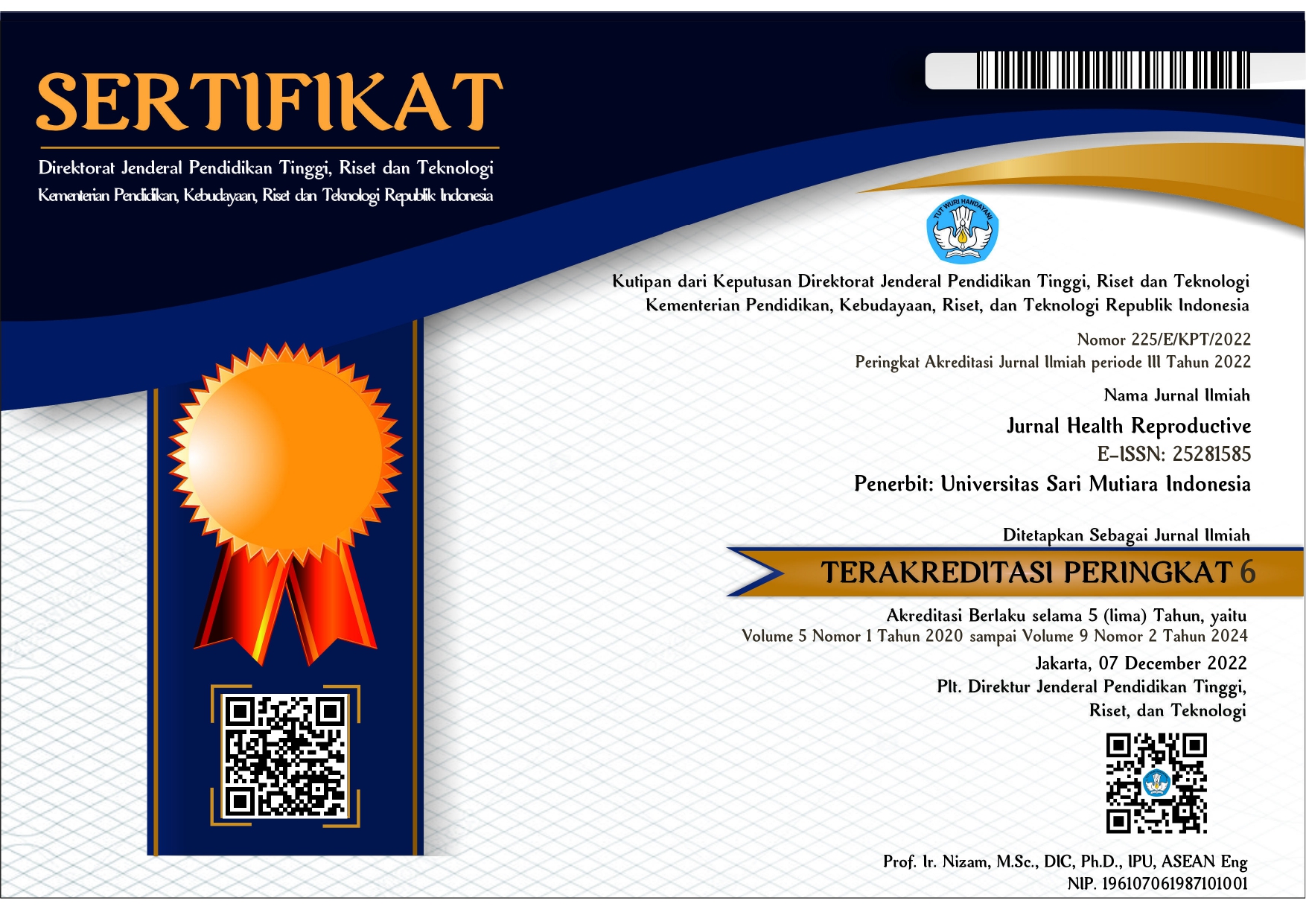PENGARUH STATUS SOSIAL EKONOMI TERHADAP KEJADIAN BAYI BERAT LAHIR RENDAH (BBLR) DI KELURAHAN GEDUNG JOHOR KOTA MEDAN
DOI:
https://doi.org/10.51544/jrh.v7i2.3643Keywords:
Socioeconomic Status, LBWAbstract
LBW is a baby with a low birth weight or less than 2500 grams, birth weight is a good predictor of baby's growth and survival. A full-term baby is generally born weighing 2500 grams or more. LBW is one of the risk factors that contribute to infant mortality, especially during the perinatal period. The incidence and mortality of LBW due to complications such as asphyxia, infection, hypothermia, hyperbilirubinemia are still high (Indrayani, 2015). This study aims to see whether there is an effect of socioeconomic status on the incidence of LBW with the type of analytic observational research and cross sectional research design. The number of samples in this study were 62 people consisting of postpartum women who gave birth to LBW or not, the results showed that there was a link between socioeconomic status and the incidence of LBW where the PValue was (0.005), this study recommends that every pregnant woman should still consume foods that are nutritious though not expensive food.
Downloads
References
Aisyah, S. dkk, 2013. Karakteristik Bayi Berat Lahir Rendah (BBLR) Sampai Tribulan II Tahun 2013 di Kota Kediri, Jurnal Penelitian Kesehatan Suara Forikes Volume 1 Nomor 3
Arif Nurhaeni. 2012. Panduan Lengkap Kehamilan dan Kelahiran Sehat, Dianloka Yogyakarta.
Asfuah, S. 2014. Gizi Untuk Kebidanan, Nuha Medika,Yogyakarta
Fatimah, dkk. 2011. Pola Konsumsi dan Kadar Haemoglobin Pada Ibu Hamil di Kabupaten Maros Sulawesi Selatan, Makara Kesehatan Vol. 15 No 1.
Indrayani, 2015. Buku Ajar Asuhan Kehamilan, Trans Info Media, Jakarta
Kep.Men.Kes, 2017 Riset Kesehatan Daerah, Badan Penelitian dan Pengembangan Kesehatan RI
, Modul Asuhan Kebidanan Neonatus, Bayi Baru Lahir, Balita dan Anak Sekolah.
Kramer M.S. 1987. Determinant of low birth weigth methodological assessment and meta analysis, Bulletin of the world health organization 65 (5) 663-737
Kusumawati, Y & Multazimah, 2011. Hubungan Pendidikan dan Pengetahuan Gizi Ibu dengan Berat Bayi Lahir di RSUD dr. Moewardi Surakarta, Infokes Volume 81.
Kusmiyati, Y. 2011. Perawatan Ibu Hamil, Fitramaya Yogyakarta
Meilani, N dkk. 2012. Kebidanan Komunitas, Fitramaya Yogyakarta
Proverawati, A & Sulistyorini, 2010. BBLR (Berat Badan Lahir Rendah) Dilengkapi dengan ASUHAN PADA BBLR dan PIJAT BAYI, Nuha Medika, Yogyakarta
Riduwan. 2008. Skala Pengukuran Variabel – Variabel Penelitian, ALPABETA Bandung
Riyanto Agus. 2011. Aplikasi Metodologi Penelitian Kesehatan, Nuha Medika Yogyakarta
Roudbari M, dkk, 2011. Prevalence and Risk Factors of Low Birth-Weight Infants in Zahedan, Islamic Republic of Iran, La Revue De Santé De La Mediterranee Orientale Vol 13 N 4
Simanjuntak, A. 2016. Hubungan Anemia pada Ibu Hamil Dengan Kejadian Berat Bayi Lahir Rendah (BBLR) di Badan Pengelola Rumah Sakit Umum (BPRSU) Rantauprapat Kabupaten Labuhan Batu Tahun 2016. Skripsi FKM USU
Supariasa I dewa Nyoman, dkk, 2012. Pensilaian Status Gizi, EGC Jakarta
Syafrudin & Mariam N, 2013. Sosial Budaya Dasar Untuk Mahasiswa Kebidanan, Trans Info Media Jakarta.
Waryana, 2013. Gizi Reproduksi, Pustaka Rihama Yogyakarta.
Yuliva dkk, 2015 Hubungan Status Pekerjaan Ibu Dengan Berat Lahir Bayi Di
RSUP DR.M. Djamil Padang, Berita Kedokteran Masyarakat Volume 25
Nomor 2: 96-108
Downloads
Published
Issue
Section
License

This work is licensed under a Creative Commons Attribution-ShareAlike 4.0 International License.











.png)
